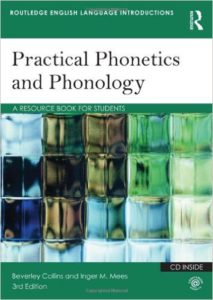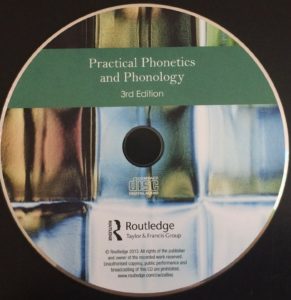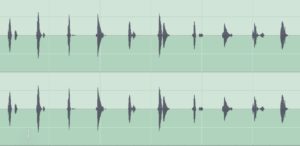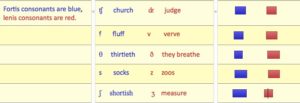Reasons to use AudioNotetaker no. 1
Text and audio available in one view
It is now possible to integrate images, text and sound (audio chunks) together in one view, on one device, where the audio is as visible, navigable, and editable as the accompanying text. This is a very important development for the teaching and studying of speech: the sound substance has a visible presence, it has the same visible status as the word on the page.
We have a history of writing about and studying sound, in the absence of sound. Ludicrous. Sonocent’s AudioNotetaker allows us to move away from this antediluvian practice by integrating images, text and sound (in the form of visible, editable, colour-codeable audio chunks) in the one view, on one device.
I’ll illustrate the advantages of using AudioNotetaker using a textbook on phonetics on phonology that is used on high-prestige courses for students of phonetics and English pronunciation such as the UCL summer school.
Below are pictures of two components of a brilliant book: Beverley Collins and Inger Mees’s Practical Phonetics and Phonology.


On the left is the printed copy of 330 pages, which I can open (with my hands) and read (with my eyes), and the CD which contains 71 tracks – for which I require a mechanical/electronic device to ‘open’ and ‘read’ in order to hear them (note the metaphorical use of the words).
Finding things in the printed book is an easy, familiar matter: there are contents pages, chapter headings, page numbers, an index, and one has one’s memory of where on a double page spread one has read something and can flick back and forth looking for that crucial quote/example/bon mot. Finding things is not so easy with the sound files. The visual memory of how things look is much less (to the point of non-existence) of a help than the printed book.
With the CD I have to look in the book to find the correct track put it in some kind of player (CD-player, iTunes) and listen to the recording. I have to switch modes from one device (e.g. a printed book) to another (e.g iTunes).
Wouldn’t it be wonderful if I did not have to switch device (from book to media player) in order to read and listen. Wouldn’t it be wonderful if I could view what I read, and see what I hear – side-by-side in the same view, in the same device.
There are a variety of ways of doing this. For example on this page I can reproduce a portion of the book (Table A2.1 p. 15) on this page/blogpost using a table and a sound player (below the table).
| ʧ | church | ʤ | judge |
| f | fluff | v | verve |
| θ | thirtieth | ð | they breathe |
| s | socks | z | zoos |
| ʃ | shortish | ʒ | measure |
To play the media you will need to either update your browser to a recent version or update your Flash plugin.
But although we know how to get the sounds out – by clicking the play button – we have no visual experience of the sound file other than the slow tracking of the playhead. It is not easy for me to find the exact beginning of one word, or bounce around from word to word.
There is a way of viewing the acoustic substance, in a wave editor, as you can see below (screenshot from Amadeus Pro) where each spike is the centre point of each word. (Although there are ways of annotating such waveforms, in my (albeit limited) experience they are not user-friendly.)
To play the media you will need to either update your browser to a recent version or update your Flash plugin.
Well, we needn’t wish any more. There is a wonderful means of having both text and audio visible in the same view – Sonocent’s AudioNotetaker. In the image below you can see a screenshot of AudioNotetaker with the same text from Collins and Mees as in the table above. (Unfortunately it does not have a web version out so I have to illustrate its capabilities with images.)
You can see three panes (a total of four are available, the image pane is not shown): two text panes (left and centre) and the audio pane on the right hand side. The left hand pane gives information about the different types of consonant listed, the middle pane shows the sample words – colour-coded to match the information – and the right hand pane shows the chunks of the sound files – also colour coded.
To play the media you will need to either update your browser to a recent version or update your Flash plugin.
So here we have, in one view, three types of visual representation: two of text, and one of sound files in the form of audio chunks. The left and centre panes show two types of content from the printed book – commentary and examples – and the right hand pane shows the audio in chunks. The audio is no longer separated from commentary and transcription, it is there side-by-side – of equal status with the written text, no longer hidden away in a different medium.
There are a number of great things about the audio chunks that is not apparent from this static image:
- you can colour-code them yourself with a couple of clicks
- you can navigate around them very quickly using arrow keys – much better than scanning back and forth across a CD
- you can cut copy and paste just as you can in a word-processor.
- you can record your own voice alongside the example and compare your version with the original
If you want to see this for yourself you need to download Sonocent’s AudioNotetaker from here (you get a 30 day free trial) and download the demonstration file from here.


